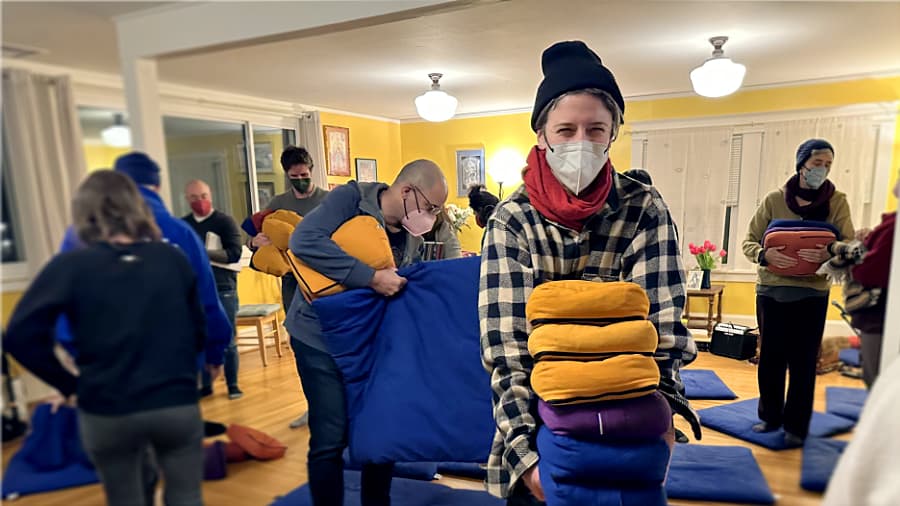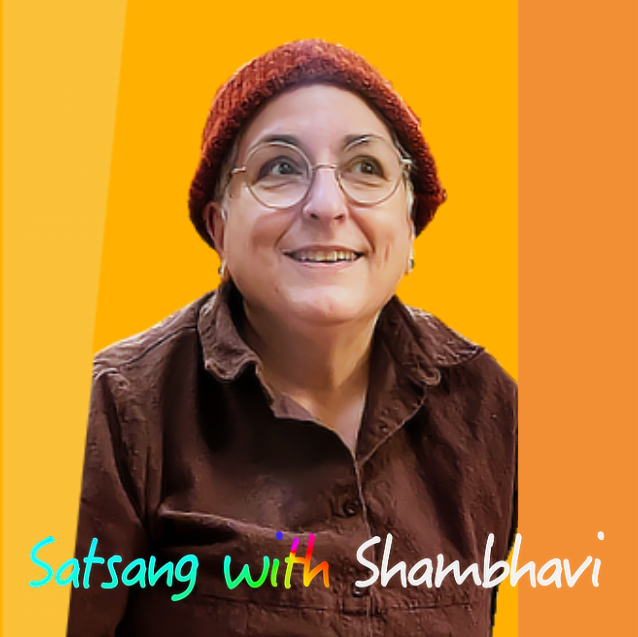Shambhavi and the Jaya Kula community gather for satsang and get real about all the questions we humans want answered. Intimate, courageous, heartfelt spiritual talk about pretty much everything. So happy you are here! A podcast from Satsang with Shambhavi
STUDENT 1
We've talked about the different forms that our devotion to God can take in terms of relating to God as a lover or as the servant of God, and I'm curious about relating to God in terms of a child or something to tend to. And I think about Ma saying that she was our daughter and like, really inspiring people to find that caretaking for each other.
SHAMBHAVI
I think that needs to be a component of a relationship with a teacher, because that's part of the alchemy of the teacher-student relationship. Ma was functioning then as a teacher.
Well, this is my interpretation anyway, what I feel about her statements: Don't call me mother, I'm your little girl. I'm your daughter. And the way that she would just like lie in her students arms and let them feed her and dress her.
And this is actually, although she did that maybe more thoroughly than a lot of others might, every teacher that I've had from India has had that same relationship with their students to some degree, where students were, in essence, tending to the ordinary wellbeing of the teacher—like cooking for them, taking care of their bodies, cleaning their houses, doing, like ordinary stuff.
I don't mean like pranaming and throwing flowers at them. I mean, the ordinary caretaking that we do. And I've always felt that this is a gateway to us learning how to take care of everyone and everything in that ordinary way.
And when I contrast my Tibetan teachers with teachers from India, wow, I mean, there's a huge contrast there in how much physical contact, intimacy, everydayness that there could be.
Certainly people, Namkhai Norbu Rinpoche, he was a householder, so he didn't show up in monk's robes, sit on a throne, give the teaching, and then leave. He would hang out with students also, like my more householder teachers from India. But there was still some kind of formality there that was not there with my Indian teachers.
So one time we were in Lima and we went to the racetrack with Rinpoche. He liked to gamble at the racetrack and he actually did this with divination. He placed his bets using divination.
So he used a very popular kind of Tibetan in divination called Mo, which is divination with beads. So he would have his mala and he would be like looking at—I know nothing about horse racing, so I really can't tell you what he was looking at—but I guess it was some sort of booklet about which horses and jockeys were racing in different races that day.
So he would be reading that, he'd be like moving the beads [laughs]. And then he would place bets according to that. And he had this cup next to him with a lid on it. So in a lot of Tibetan traditions, there's cutlery and dishes that are only for the teacher no one else uses them and they're put in a separate cabinet.
I mean, even some of the American Buddhist teachers do that. They're not like great Rinpoches or anything, but they still follow that tradition of having separate utensils and dishes.
So Rinpoche had his special cup next to him and it had a lid on it. And I was terrified. For some reason, I got stuck sitting very close to him.
I had no idea what the protocols were and the formalities of it just felt kind of foreign to me compared to what I was used to with my Indian teachers. I was afraid I was going to do some terrible faux pas—clink the lid down on the teacup too loudly, or I don't know what.
But anyway, luckily for me, some other student was there, and I guess she saw me like kind of like this, and she came and took my place. And so she was filling Rinpoche’s cup. But it was obvious that there was a protocol to it, right?
Where you see movies of Ma or photographs of students relating to Ma and feeding her food and drink, they're literally putting it in her mouth. They're sitting so close to her and even in fact, there's some photographs of her lying in students laps while they spoonfeed her.
So even Rinpoche who was so much less formal than other Tibetan teachers I've had, even there, there was like a barrier of some sort.
So my feeling about this from having witnessed this and participated in this to some degree is that this is to show us how to take care of people and how to take care of things. That we're being trained in caretaking, and that this is why Ma did this.
And she said explicitly, you're a little bit afraid of the mother and the mother's taking care of you. But the daughter, you just love the daughter without any inhibition. And that wasn't exactly the word she used but it was something to that effect.
You just love your children without any inhibition and you take care of them. And this is what she wanted people to do. Obviously, not with her, only. It wasn't about herself, it was about how we should relate to everything.
The only daughter God that I know of is Kali. I was given Kali sadhana to do and it suddenly dawned on me when I was doing it that she was Durga's daughter, and that no one really relates to the daughterness of Kali, right?
I mean everyone knows she's Durga's daughter, that she was the concentrated shakti of Durga, and that she was emitted from Durga's third eye, making her Durga's daughter. But no one ever really talks about it like that or like elaborates on her as a daughter.
And that was actually my entry point into the sadhana, because at that point in my life, I very much identified as a daughter and felt very like daughterly myself. So I was having a hard time with the Kali sadhana. I was having a hard time sort of feeling much about it, and that was kind of my entry way into feeling a connection with Kali.
But I've never come across like, any incarnations of God who are like specifically worshiped as daughters, or sons, or children. I mean there’s Bala Krishna, you know there's baby versions of the deities.
But again, even though we say Bala Krishna, it's more like, Oh, how cute and how playful and how sweet, but it's not really doing the same work that happens between teacher and student. It's still more like just an expression of them that's not really demanding anything different from us. [laughs]
And of course, Hinduism is vast and over the top, varied, wildly varied. So there's probably some expressions of deities that are actually worshiped in their daughterliness or son-ness, but I'm just not aware of them. But it's definitely a feature of most of the Indian teachers that I've had, their relationships with their students.
I've also told the story of this other Indian teacher I had, Shibendu Lahiri. And when I went to a retreat at his compound in Varanasi he had really horrible sciatica, the kind of sciatica that you need to get an operation for.
It turned out he had some kind of cyst that was like causing this just tremendous pain and he was having a hard time even walking. And so part of the retreat he gave from his bedroom lying down. [laughs] And there were students surrounding the bed, sitting right up next to the bed, like massaging his body with 20 different pairs of hands. [laughs]
I can't imagine this happening in any other tradition. It was just so striking. And the rest of us were just crowded into that bedroom like sardines all around his bed, up to the walls, spilling out the door of the bedroom.
You couldn't even move in there. And he just laid in his bed and gave teachings for hours.
When I first went to India, this kind of terrified me. It even terrified me in the temples, because when you go to a temple in India, a lot of them, like people are just throwing themselves at the murtis. They're throwing themselves at the deities, crying out and weeping and stroking them and throwing themselves at their feet of the murtis.
And this was just like [laughs] you know, it was just so intimidating to me. [laughs] I really didn't know what to do with myself in those situations.
And people would be just like, crowding. Not only would they be throwing themselves at the deities, but everyone in the temple was like a fraction of a millimeter apart from all the other people there. People just like pressing up against you, this like mass of humanity throwing themselves at these deities. [laughs]
There's something absolutely marvelous about it and absolutely terrifying at the same time.
STUDENT 2
I've been thinking a lot about the decision making technique you were talking about, just trying to tune into your body and have that first thought, best thought be the indicator. And I feel like sometimes I lead with fear or have a fear thought first.
SHAMBHAVI
You're actually making me realize that that phrase isn't really the best phrase—first thought, best thought—because it really isn't a thought that we're trying to find, right?
Your first thought or feeling might be fear, but there's actually something that comes before that, and then the fear kicks in. And when we have patterning of a lot of fear, it's harder to find that thing that comes before because it disappears quicker.
So that thing that comes before is more of just an upsurge of knowing. It's like first know, best know. It's not really a thought. It feels like a, it's just a [clap] like that, or an upsurge of something, and it speaks to us, but not in words.
It's neutral. It has this kind of neutrality. In my experience of it, it has no emotional content at all. It's just an answer.
So I experienced that in my heart space and again, it's not a word, it's not a sensation necessarily. But different people, I'm sure, experience things differently in this regard, like how knowledge comes to you. But it's basically an up surge of direct wisdom.
And so it has that feeling of coolness, what's called in Ayurveda, saumya, a cool quality, a neutral cool quality. And I think for someone who feels a lot of fear, then to train yourself to be able to even find that pre-moment before thinking and fearing kicks in would be the first step in that.
And then the two roads meditation might be better because that gives you more time to feel into your body and energy. Where do you feel more relaxed? Like, on which path do you feel more relaxed and less fear?
So check that out. But it might be a while of like giving it a try numerous times before you can actually, Oh, there that is! Right? That wisdom that's coming, the unconditioned, the absolute that's coming before the conditioned fear.
But I'm convinced everybody has that moment, but it can be very fleeting.
For instance, people who are obsessively planning things have a hard time identifying that moment when you're just waking up in the morning and you're in this zone of openness because they're used to waking up and the minute they come to consciousness, they start planning their day. So that also takes training to get out of that and be able to identify that gap between sleeping and waking.
So there's all kinds of moments like that, they're called sandhi in Sanskrit: S, A, N, D, H, I. We're always playing with those sandhi.
You asked the question and the gap between the question and your usual conditioning, right, is called a sandhi. And that's where wisdom emerges from.
So depending on how heavy our conditioning is, it's going to be more or less easy to identify that gap. But you can train yourself to do it, right, with some perseverance.
I'm never going to say first thought, best thought again. Now I'm realizing it's the wrong way to express it. First wisdom, best wisdom, maybe.
STUDENT 3
When I have an understanding of what's going on on a conceptual level, then I don't give myself any slack for like it still feeling hard. That like somehow the understanding mitigates or negates the actual still like, emotional response, and like I need to make more room for like how it feels and not let that understanding like cut it off at the knees.
SHAMBHAVI
So you have Western culture to thank for that misconception. [laughs] We're going to categorize and label and name and explain, and then we're going to feel all good. Everything's going to be resolved.
And of course, this was the Freudian method. So you also have a little Viennese guy from the 19th century to thank for this even more seeping into you, that somehow just understanding things in this way, which is really just explaining them, sort of, is a cure for something, right?
It's not. It really has nothing to do with it. And any explanation that we have, of course, is so limited. The way that we explain things cuts out 99.999999999999% of all of the rest of life.
We just get this tiny little zone—my childhood, or my relationship with you, or some little minuscule zone in this vast life. And we base an explanation on that teeny, weeny, weeny, weeny little bit of life. And then we expect it to resolve things that are arising in us from infinite causes and effects.
It's just ludicrous, actually. That's all I have to say about that. So pay more attention to your actual experience, your lived immediate experience, and just try to explore that more.
You don't need an explanation for it. Explanations are hugely overrated—huge, huge, hugely overrated.
We're also just missing out on so much. Like feelings aren't the only things that we could be relating to either. We have this like incredible over-emphasis on emotion, also.
But what about texture, right? There's all kinds of textures that we're constantly moving through with people and circumstances and subtle flows that aren't really about emotions, subtle energies and color and form and sound and taste.
We're just in an ocean of sensation and wisdom, and yet we're like, I feel this, I… [laughs] Again, we just have our culture to thank us for these monomaniacal mini-foci of our lives.
But getting more into sensation and its more layered and textured modes and colors and forms and movements and relating to things more like that is also very helpful. Feeling the air on your skin, something that simple.
But we're just walking around as someone I knew long ago said, like brains on sticks. It's just a very, very impoverished way to live, very impoverished. See if you can get into all of your senses, not just emotions, not just mind.
Sign up to receive email updates
Enter your name and email address below and I'll send you periodic updates about the podcast.


